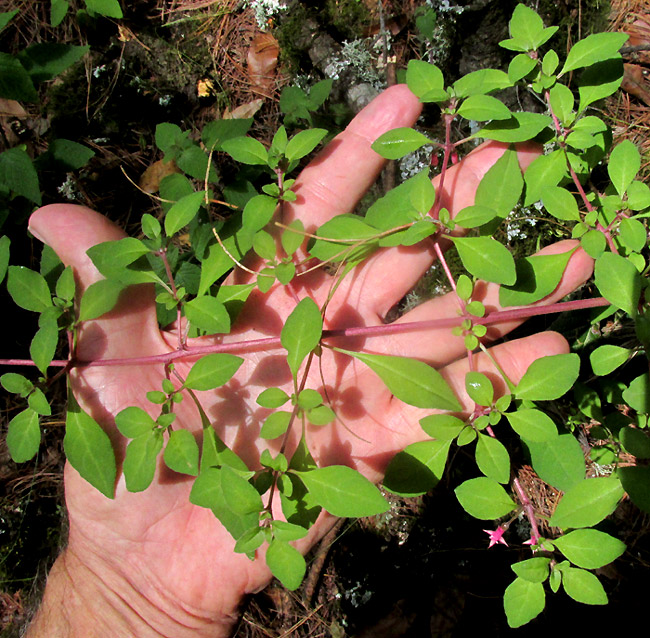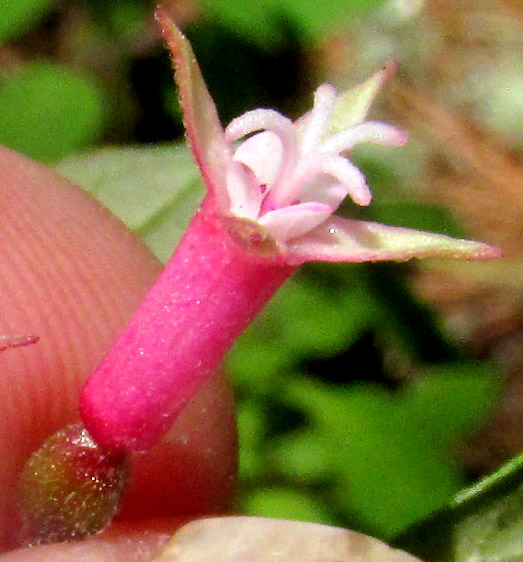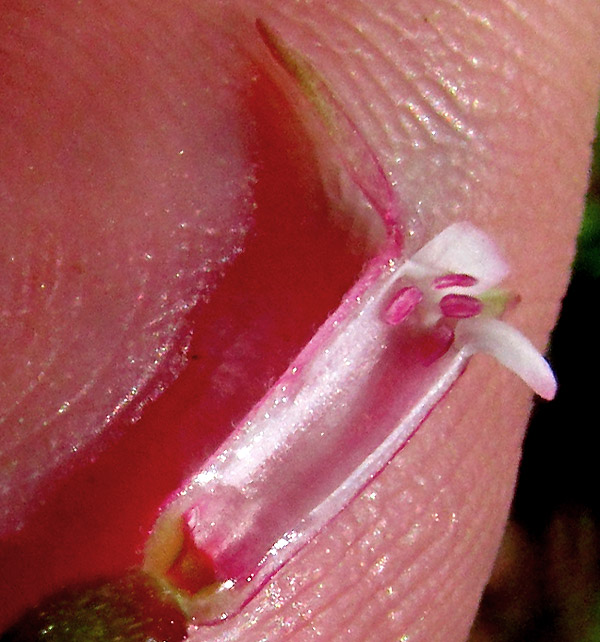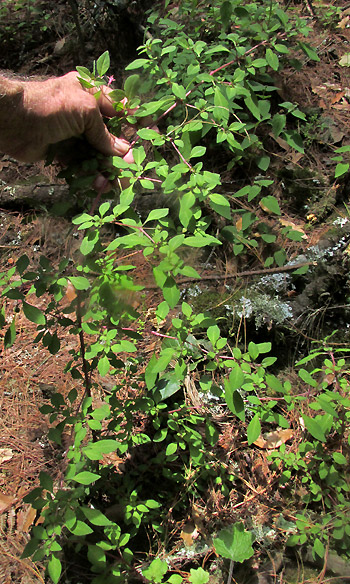Excerpts from Jim Conrad's
Naturalist Newsletter
Entry from field notes dated September 2, 2023, taken in Los Mármoles National Park in the Eastern Sierra Madre mountains, Hidalgo state, MÉXICO; oak-pine forested slope about 3km west of Puerto de Piedra, on road branched off the road between Trancas {on maps designated "Morelos (Trancas)"} and Nicolás Flores; limestone bedrock; elevation ~2,620m (~8,600ft); N20.816°, W99.213°
THYME-LEAVED FUCHSIA

In a narrow beam of sunlight on a usually shaded slope, the above branch of a woody shrub caught my eye with its handsome pink stems bearing light-green leaves. Leaves and branches jutted out at right angles from their bases, affording maximum leaf exposure to what little sunlight was available.

Sharply tipped leaves arose opposite one another at stem nodes, and the leaves narrowed gradually to particularly long, slender petioles. Blade margins exhibited the merest hints of three to five low teeth, or no teeth at all. The entire bush bore only about six flowers, but they were interesting ones with pink floral tubes arising from green, pealike, oval ovaries on long pedicles. White, oversized, four-lobed stigmas extended well beyond the tubes.

Above, notice the small, white, scale-like items at the bases of the tube's much longer lobes. They're corolla petals, for the pink tube with its petal-like lobes constitute a four-lobed calyx modified to perform the pollinator-attracting service usually accomplished by the corolla. With the ovary below the floral tube, it's an inferior ovary. Since relatively few plant families produce inferior ovaries, that's an important field mark for identification.

Cutting the floral tube down its center reveals that it is mostly empty, though four pink, surprisingly small anthers cluster at the tube-half's top. This suggests that the flower produces eight stamens in all. Also atop the tube, two of the four short, white petals are visible, plus, approaching the picture's top, there's a single, much longer sepal lobe, the other three sepal lobes having been removed.

At the right, the whole plant, despite the elegance of its parts seen close-up, at a distance looks a bit untidy.
So, what plant family can produce species in which pairs of simple leavews appear at stem nodes, the symmetrical flowers have inferior ovaries, the calyxes and corollas are four-lobed, and there are eight stamens? The Evening Primrose Family, the Onagraceae, can do that, and that family is known for offering some very pretty flowers.
In our part of upland central Mexico, the only genus of the Evening Primrose Family displaying such a floral tube, or hypanthium, and flowers with eight stamens along with really short petals compared to the larger petal-like calyx lobes, is Fuchsia. About 110 Fuchsia species are recognized, the vast majority of which are South American, with only a few occurring in Central America and Mexico, plus some in New Zealand and several Pacific islands. Certain fuchsia cultivars, developed from just a few wild species, are among the world's most appreciated ornamental plants.
The 2021 study by José Luis Villaseñor and others entitled "Riqueza y distribución de la flora vascular del estado de Hidalgo, México" reports that here in upland central Mexico's Hidalgo state eight Fuchsia species are documented. Of those eight, if the flowers are produced singly in leaf axils, the flowers produce both male and female parts, and leaf margins are toothless, or with only a very few low, widely spaced teeth, you have FUCHSIA THYMIFOLIA. In English, Fuchsia thymifolia is known as the Thyme-leaved Fuchsia; it's distributed in highland forests and along roadsides in such areas from central Mexico south into Guatemala.
One wonders about flowers producing such large, conspicuous stigma arms, but whose stamens bear such small anthers. C. Cervantes and others in a 2018 study entitled "Small but attractive: female-biased nectar production and floral visitors in a dimorphic shrub," wondered the same. The authors describe the sexuality of Fuchsia thymifolia as "morphologically gynodioecious but functionally subdioecious," further remarking that seed production is largely restricted to female plants.
Gynodioecious species bear only female flowers on some plants, while other plants of the same species bear flowers that either are bisexual, or else both unisexual male and unisexual female flowers. The above study found that bisexual blossoms were larger than strictly female flowers, but didn't produce nectar, or produced much less nectar than female flowers. The pollinators -- 68% flies and 24% bumblebees -- preferred the small female flowers. Apparently larger, nectar-poor blossoms are mostly for attracting pollinators to the plant, and pollinators learn to visit the smaller ones. I'm unsure which kind of flower is shown above, but the anthers look runty, so I lean toward it being a smaller, nectar-producing female flower. Supporting that guess is that at the floral tube's base something glistens like nectar.
Fuchsia thymifolia doesn't produce large, multicolored blossoms like the hybrids sold to gardeners, but it is grown in many gardens. It's described as a relatively low maintenance plant preferring partial sunlight. In temperate climates it's treated as an annual, since it doesn't survive freezes. Sometimes it's grown in pots and baskets.
The online Biblioteca Digital de laMedicina Tradicional Mexicana reports that traditionally in Mexico the plant has been used for algodoncillo, in English known as oral thrush, which is a common mouth infection among babies; also it's been documented used for scurvy, coughs and diarrhea. Teas can be made of the upper parts.